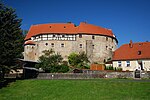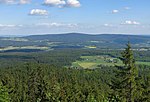The German Continental Deep Drilling Programme (German: Kontinentales Tiefbohrprogramm der Bundesrepublik Deutschland, lit. 'Continental deep-drilling program of the Federal Republic of Germany'), abbreviated as the KTB borehole, was a scientific drilling project carried out from 1987 to 1995 near Windischeschenbach, Bavaria. The main super-deep borehole reached a depth of 9,101 m (29,859 feet) in the Earth's continental crust.
The Federal Ministry of Research funded the project with 528 million DM (270 million euros). The (Lower Saxony) LBEG mining office (State Office for Mining, Energy and Geology) took the project lead. After the drilling project ended, the German Research Centre for Geosciences used the borehole to install a seismic deep observatory (Tiefenobservatorium) which was active from 1996 to 2001. The derrick used at the site, one of the largest in the world, remains in place and has become a tourist attraction. The two boreholes were kept open for further scientific research and for in-situ testing of equipment and devices.











